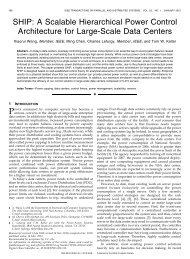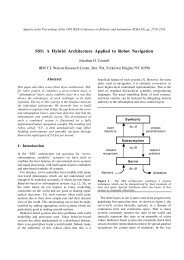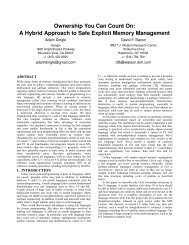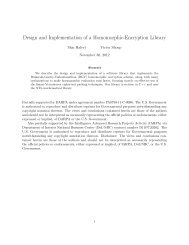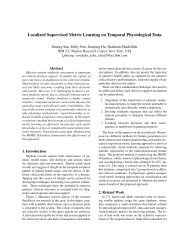On Nearly Orthogonal Lattice Bases and ... - Researcher - IBM
On Nearly Orthogonal Lattice Bases and ... - Researcher - IBM
On Nearly Orthogonal Lattice Bases and ... - Researcher - IBM
Create successful ePaper yourself
Turn your PDF publications into a flip-book with our unique Google optimized e-Paper software.
6.5.4 Experimental ResultsWe tested the proposed approach using a wide variety of test cases. In reality, the decompressed image P dis always corrupted with some additive noise. Consequently, to estimate the desired compression history,the approach described above was combined with some additional noise mitigation steps. Our algorithmprovided accurate estimates of the image’s JPEG compression history for all the test cases. We refer thereader to [22, 23] for details on the experimental setup <strong>and</strong> results.7 Discussion <strong>and</strong> ConclusionsIn this paper, we derived some interesting properties of nearly orthogonal lattice bases <strong>and</strong> r<strong>and</strong>om bases.We chose to directly quantify the orthogonality of a basis in terms of the minimum angle θ between a basisvector <strong>and</strong> the linear subspace spanned by the remaining basis vectors. When θ ≥ π 3radians, we say that thebasis is nearly orthogonal. A key contribution of this paper is to show that a nearly orthogonal lattice basisalways contains a shortest lattice vector. We also investigated the uniqueness of nearly orthogonal latticebases. We proved that if the basis vectors of a nearly orthogonal basis are nearly equal in length, then thelattice essentially contains only one nearly orthogonal basis. These results enable us to solve a fascinatingdigital color imaging problem called JPEG compression history estimation (JPEG CHEst).The applicability of our results on nearly orthogonal bases is limited by the fact that every lattice doesnot necessarily admit a nearly orthogonal basis. In this sense, lattices that contain a nearly orthogonal basisare somewhat special.However, in r<strong>and</strong>om lattices, nearly orthogonal bases occur frequently when the lattice is sufficientlylow-dimensional. Our second main result is that an m-D Gaussian or Bernoulli r<strong>and</strong>om basis that spans alattice in R n , with m < 0.071n, is nearly orthogonal almost surely as n → ∞ <strong>and</strong> with high probability atfinite but large n. Consequently, a r<strong>and</strong>om n × 0.071n lattice basis contains the shortest lattice vector withhigh probability. In fact, based on [31], the bound 0.071 can be relaxed to 0.25, at least in the Gaussian case.We believe that analyzing r<strong>and</strong>om lattices using some of the techniques developed in this paper is afruitful area for future research. For example, we have recently realized (using Corollary 3) that a r<strong>and</strong>omn × 0.071n lattice basis is Minkowski-reduced with high probability [8].AcknowledgmentsWe thank Gabor Pataki for useful comments <strong>and</strong> for the reference to Gauss’s work in Vazirani’s book.We also thank the editor Alex<strong>and</strong>er Vardy <strong>and</strong> the anonymous reviewers for their thorough <strong>and</strong> thoughtprovokingreviews; our work on r<strong>and</strong>om lattices was motivated by their comments. Finally, we thank GregorySorkin who gave us numerous insights into the properties of r<strong>and</strong>om matrices.References[1] E. Agrell, T. Eriksson, A. Vardy, <strong>and</strong> K. Zeger, “Closest point search in lattices,” IEEE Trans. Inform. Theory,vol. 48, pp. 2201–2214, Aug. 2002.[2] M. Ajtai, “The shortest vector problem in L 2 is NP-hard for r<strong>and</strong>omized reductions,” in Proc. 30th annual ACMSymp. Theory of Computing, pp. 10–19, ACM Press, 1998.[3] A. Akhavi, J.-F. Marckert, <strong>and</strong> A. Rouault, “<strong>On</strong> the Lovász reduction of a r<strong>and</strong>om basis,” 2004.Submitted.19









